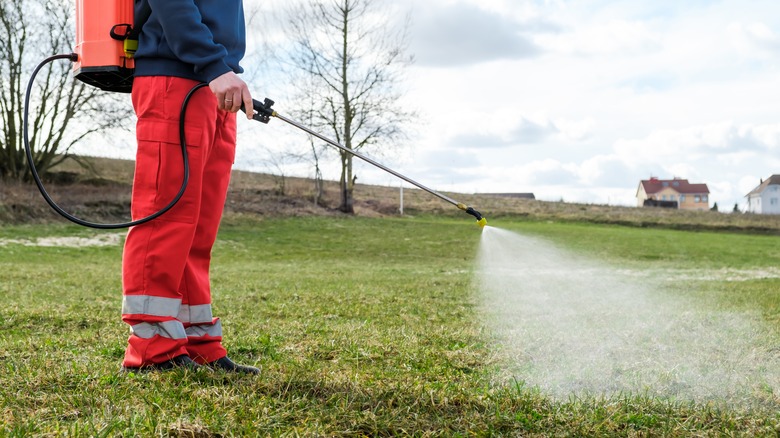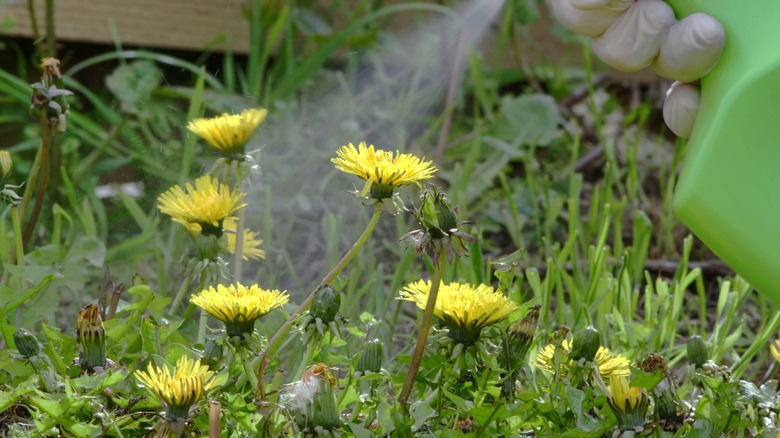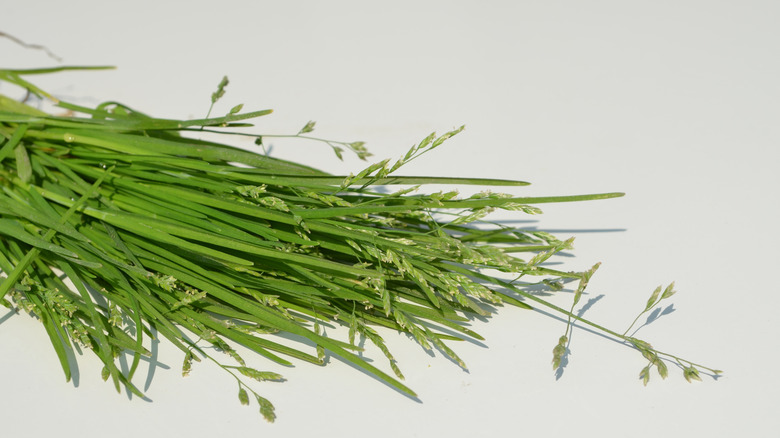Plants That Celsius Weed Killer Can And Cannot Get Rid Of
We may receive a commission on purchases made from links.
If you need a fast way to get rid of weeds in your garden or other parts of your landscape, a herbicide such as Celsius WG weed killer may be your solution. Celsius weed killer is in the postemergence category, meaning you can use it to control weeds that have already sprouted. It can help protect your warm-season grasses to keep them lush and healthy.
So what exactly can this particular weed killer help with? The answer is over 120 weeds. Use it on broadleaf weeds — weeds characterized by veiny leaves and nodes bearing one or more leaves. The American burnweed (Erechtites hieraciifolius), chamberbitter (Phyllanthus urinaria), Florida betony (Stachys floridana), spotted spurge (Chamaesyce maculata L.), and Virginia buttonweed (Diodia virginiana) are just some of the weeds in this category that this herbicide can handle. How about those grassy weeds — ones that grow from a base with parallel leaf veins? Carpetgrass (Axonopus), large crabgrass (Digitaria sanguinalis), and doveweed (Murdannia nudifflora) are among the grassy weeds Celsius can target.
This herbicide is highly effective despite using 25-75% less active ingredients than its postemergence herbicide counterparts. However, there are some plants that Celsius cannot get rid of. Do you have annual bluegrass? You'll need something else to control poa annua in your lawn and it only suppresses dallisgrass (Paspalum dilatatum), but doesn't kill it.
Best ways to use this weed control
Weeds can quickly reproduce and compete with your existing crops for nutrients. With an effective herbicide like Celsius, you can protect Bermuda (Cynodon dactylon) and St. Augustine grass (Stenotaphrum secundatum) — two popular warm season grasses you shouldn't plant together. Zoysia is another beautiful grass that can stand up to foot traffic, heat, and drought. Protecting these can start with learning how to effectively apply Celsius.
Once you have properly identified what type of weed you have, mow the lawn to an appropriate height and water the soil for better weed exposure and herbicide absorption. Use goggles and gloves to protect yourself before you begin spraying.
Its granule form mixes easily with water that you should put in a sprayer. Mix with a non-ionic surfactant, such as the Voluntary Purchasing Group Spreader Sticker, for complete leaf coverage and increased absorption and contact kill. It should start taking effect a few hours after spraying and you'll notice weeds changing color (yellow, red, or purple) and showing signs of death, which should happen in about 1 to 4 weeks. Be aware of weather as fog, dew, or rain can reduce effects. Try to wait until temperatures are around 60 degrees Fahrenheit and check forecast to ensure it won't rain the next day. Doing so prevents having to reapply the herbicide. If you have isolated weed problems that are harder to treat, only use more herbicide in those areas — don't treat the whole lawn again.
What plants are resistant to Celsius Weed Killer?
Annual bluegrass can spread quickly and can leave behind seeds that will live in your soil for years. Therefore, you need methods that can create vulnerabilities in this weed. Unfortunately, Celsius weed killer isn't one of them. If you see it in small patches, hand-pulling is effective, as long as you get the entire root system. Moderate invasions can be conquered with mulching or vinegar, but you will likely need chemicals for larger ones. Primesource Meso 4 SC Select and Certainty for Turf and Lawns are recommended solutions for this weed.
Most of the southern United States deals with dallisgrass, a troublesome gray-green weed that can be toxic to livestock. Celsius weed killer can suppress it when you use it with Revolver. Make sure to apply your herbicide in early to late fall during dalligrass' active growth period for better control. Proper timing of multiple applications is essential, with the first one happening once the temperature dips below 72 degrees Fahrenheit for three consecutive days in September or October, the second one about 4 to 6 weeks later, and the third one in the spring during regrowth.
As you can see, there are many weeds that Celsius weed killer can help you eliminate or at least suppress. Before you buy this product, make sure you don't have annual bluegrass or any other resistant weed. With proper mixing, application, and weed identification, you can remove many invasive species from your turf.


